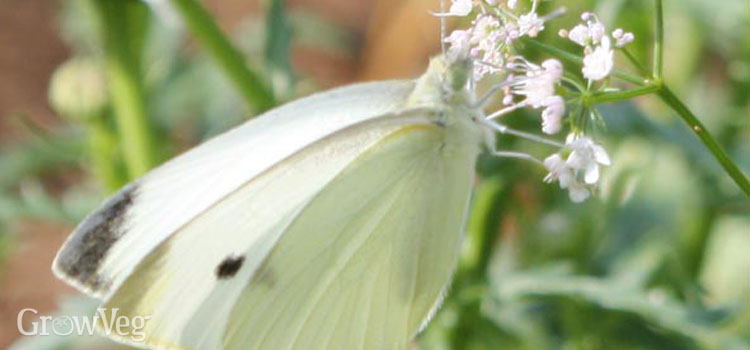Are Sulphur Butterfly Caterpillar Bad For My Garden
Cabbage White Butterflies – How to Avoid a Brassica Massacre

Like many gardeners, I've been unfortunate enough to experience some brassica damage in the past. A few tattered rutabagas, a holey kale plant – tell-tale signs that Small Cabbage White butterflies had laid their eggs on my plants. I considered the damage annoying, but it never reached really troublesome proportions in my garden.
Last year when I spotted large numbers of Cabbage Whites flying around, I didn't pay much attention to them at first, as I had (fortunately, as it turned out) decided not to grow any brassica crops. I do grow nasturtiums along the vegetable patch fence however, and within a matter of days I went from 'Oh look – that's an interesting caterpillar' to 'Eek! What are those caterpillars and what have they done to my nasturtiums?'
Large and Small Cabbage White Butterflies
It turns out that the Small Cabbage White butterfly, while undoubtedly a pest, is nothing compared to its big brother, the unimaginatively-named Large Cabbage White. The two are very similar, but the caterpillars, or cabbageworms, are distinct – the Small Whites are an unassuming pale green colour, while the Large White larvae sport a hairy black and yellow jacket.

Both butterflies are widespread throughout Britain and Europe, and the Small White has also been introduced to North America, Australia and New Zealand (sorry guys!), where it's often known as the 'imported cabbageworm'. If it's any consolation, the Small White is less of a voracious feeder than the Large White – as I discovered, when half a dozen robust nasturtiums were reduced to skeletons.
As the name suggests, cabbages and other brassicas are the favored food plants of the Cabbage White larvae. The butterfly will lay eggs on the undersides of leaves (singly in the case of the Small White, in groups of 40-100 by the Large White) and after a week or two the larvae will emerge, like the Very Hungry Caterpillar in my favorite childrens' book, ready to eat whatever lies in its path. Small Whites will tunnel into the hearts of cabbages, so even if they're around in fewer numbers, a handful of larvae can still do serious damage to your crop.
Protecting Against Cabbage Whites
So how do we stop them from destroying our crops? Well, prevention is always better than cure, so the first step is to invest in some good, butterfly-proof netting. I've draped mine over hoops to make it easy to throw it back for weeding and harvesting.

Make sure the barrier is firmly held down at the edges, with no gaps that butterflies could squeeze in through – I prefer to use bricks rather than pegs, which tend to tear netting and shorten its life. Alternatively, burying the edges into the soil will make absolutely sure that there are no gaps.
You can use the Netting icons in our Garden Planner to mark on your plan where you need it in your garden. If you're not sure which of your crops are likely to be affected, use the Custom Filter button to show only brassicas in the selection bar, and group these together under your netting.
Cabbage Whites produce two broods per year (three in a favorable summer), so make sure to install the netting in spring and don't remove it until autumn. Even under netting however, regular inspection of leaves is essential. Hand-picking eggs and larvae off the plants can be laborious, but it is effective. Small White larvae are well-camouflaged, so make sure to check the ribs of leaves where they often hide. Growing red-leaved varieties of cabbage and other brassicas can make it easier to spot them.

Cabbage White Predators
As any organic gardener knows, encouraging natural predators is a great way to control pest populations (and saves you having to perform grisly executions personally). Cabbage white larvae have a trick up their sleeves though – they accumulate mustard oil in their bodies from the food plant, which makes them unpalatable to most predators. Some birds will still eat them however, so it's worth providing feeders and nest boxes to encourage insectivorous birds such as house sparrows, goldfinches and skylarks into your garden.
Large White cabbageworms can fall prey to the larvae of Apanteles glomeratus, a parasitic wasp, which devours the caterpillar from the inside out, carefully avoiding the vital organs so the host continues to grow to full size. If you find any dead caterpillars with yellow cocoons next to them, it might be worth moving them among your brassicas so that the parasites will attack further generations.
Once fully grown, the larvae will move away from the food plants and make their way to somewhere sheltered such as a fence, shed wall, or tree trunk, and pupate for around two weeks in summer, or eight weeks for overwintering pupae, so it's a good idea to check these areas and remove any you find.
Surprisingly considering the devastation wreaked on my nasturtiums I didn't find a single pupa over the winter, but spiders seemed to have a feast on the larvae last year and I've seen butterflies caught in their webs this year too.
Despite the likelihood of total annihilation, I am growing nasturtiums again – hopefully their presence will distract the butterflies from trying to squeeze in under my netting and I'll enjoy a good crop of broccoli later this summer!
By Ann Marie Hendry.
< All Guides
Are Sulphur Butterfly Caterpillar Bad For My Garden
Source: https://www.growveg.com/guides/cabbage-white-butterflies-how-to-avoid-a-brassica-massacre/
Posted by: longcomem1980.blogspot.com

0 Response to "Are Sulphur Butterfly Caterpillar Bad For My Garden"
Post a Comment